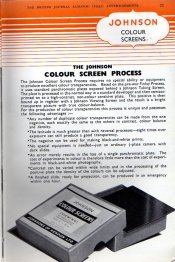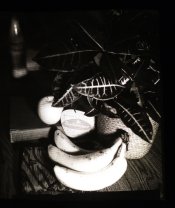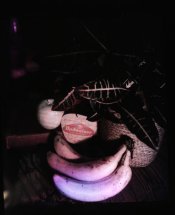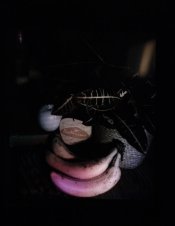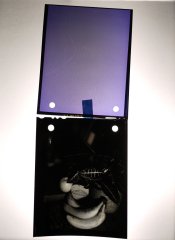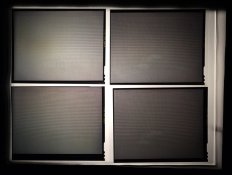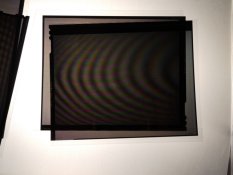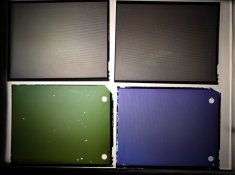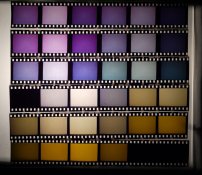Let's Get Up To Speed...
Guru, I appreciate that, thank you.
Ok, here is some updated information regarding things that I've already done, but have thus far been poorly illustrated.
Image #1. This is the b&w positive image that was exposed under a screen-plate, developed by dr5 (Delta 100). The slide looks exponentially better in person... these digital cameras can't do justice to the brightness range in the least.
#2-3. These are my best attempts at lining up the screen with the positive and achieving the best color. One exposure favors color while the other attempts to show the range of brightness evident in person.
The reason the banana is pink is because the screen and b&w film were not flush during the exposure, making registration nearly impossible at this stage. The most realistic color can be seen in the leaves of the ______ (my roommates sleeping otherwise I'd ask him what plant it is), the white painted apple and the Budweiser coaster. Can anyone identify the book?? Reading this whole thread would probably give it away....
#4. The screen and the positive; note the scuff-mark on the screen, result of not cleaning the television very well before making the screen. The same thing happened with my most recent screens too unfortunately. Cleanliness is important! The blue hue is quite apparent in this screen, but it actually seemed to balance out tungsten illumination well. It resembles an 80a filter I think. Also note registration holes; courtesy of a 2-hole punch. The sheets are stuck emulsion to emulsion for best sharpness.
#5. My newest screens. This time I used a Wratten #6 filter (light yellow) to cancel out the blue hue of the previous TV-screen-plate. Very neutral, but under loupe the greens appear a tad yellow. Who know's, I'm excited to try these. (note scuffs on screens! aahh!)
#6. Example of extreme moiré, importance of perfect and flush registration.
#7. Examples of variability in screen neutrality. Disregard the damage on the green screen, this is due to using it as a test sheet for binding with gelatin, unbinding, etc. (it's been abused). The striking green hue is result of the LCD flat screen computer monitor used for that exposure. The back-light in these is fluorescent, discontinuous and wreaks havoc on film, particularly EPP which I think is kind of an old school slide film. Tests with E100VS proved less extreme. The blue is an unfiltered CRT TV screen, the gray ones are w/ #6 wratten filter.
The blue réseau here is awaiting development of its companion b&w positive. The damage around the edges is caused by the gelatin/sorbitol mating. Probably in large part due to fingernails and trying to get the sheets "unstuck" underwater, in complete darkness. However, I'm quite pleased since it's mostly confined to the non-image areas. I'll be lining it up with it's positive as soon as I reversal process it. Registration is likely to be excellent, but seeing as this will be my first time to ever reversal process film, the quality of the positive will be at the mercy of the darkroom gods.
#8. These are tests with E100VS and various filter combinations. I did 3 shots with each filter, +1, 0 -1. My ghetto-rigged light table doesn't have the most even illumination however. The first 18 are shots of a LCD monitor; I added magenta to them to reduce the green cast, but apparently EPP and E100VS act quite differently as nearly all of these were way too magenta. These were the filters used in chronological order. 40M, 30M, 50M, 20M, 30M+20C, No Filtration. The results may be inconclusive honestly.
Skip the one underexposed random photo (it's supposed to be a glowing stove, since I stopped to make tea while taking these damn pictures...)
The next 15 are pictures of the TV. Respectively, in groups of 3; No Filtration, #3, #6, #8N5 (I don't have just a #8), #9. I concluded that the wratten #6 was the most neutral and it seemed to translate well to EPP.
______________________________
So basically this is the current state of affairs. I still have a lot of hope for this method, and I know that one day that I'll be looking at an excellent color picture produced in this manner.
I'd encourage anyone else out there to give it a shot themselves and let's see what the world looks like through a screen-plate!



